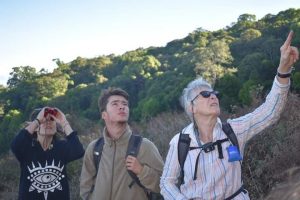Discover how Namib Desert wildlife thrives in extreme conditions – elephants, beetles, plants & more adapt uniquely to survive harsh environments.
GVI
Posted: July 9, 2024

Posted: November 26, 2020
At GVI Chiang Mai we like to keep the volunteers busy with lots of different projects; we do more than just elephant hikes! The area we are in has a huge variety of different species, and so we are always trying to develop our biodiversity programme further. We run two morning biodiversity hikes a week as well as afternoon activities such as birding. As the seasons change here, different animals and plants have their season.
During the dry season, the snake breeding season is in full swing and night hikes go out regularly to document the different snakes in the area. At other times of the year, we still run regular night hikes which usually involve walking along the river, and always see at least one snake as well as many frogs, spiders and fish. We try and get the volunteers interested in taking photos so we can document what we see on these hikes.
We also teach the volunteers the birds in the area and do birding point counts; this includes being quiet for 5 minutes to give the birds time to start displaying natural behaviour, and then documenting all bird sightings for 15 minutes. We are building up a database of this to spot any trends.

We are very lucky to have a population of Lar Gibbons -an endangered species – right on our doorstep. It is not uncommon to hear their unique calls on elephant hikes, but they are an elusive creature and hard to spot; sighting a gibbon is down to luck. When there is a sighting, news circulates quickly amongst the staff/volunteers and we organize a gibbon hike to try and spot them in the same area the following day. We are proud to have these amazing creatures within walking distance of our base.
Improving the biodiversity aspect of the program is not simply for the interest of volunteers; we want to make a wider contribution, since so little is known about the biodiversity of this area of Thailand. During our ‘Bio ID’ sessions, which take place every week, we encourage volunteers to bring pictures of any interesting animals or plants they have taken whilst being on project, we put them up on the projector and pore over our many Thailand animal and plant books trying to identify the specimen. We can then record the species and location on an online database called iNaturalist, where it is shared online with other scientists all over the world!
It’s great that volunteers can come to this very unique part of the world and not only learn about the elephants and community here, but also be educated about biodiversity. We hope this will encourage them to continue taking an interest in the natural world even after leaving the project. We hope that the villagers here will also be encouraged to take an active role in preserving the natural world, as they recognise that it can bring in tourism and income.
Discover how Namib Desert wildlife thrives in extreme conditions – elephants, beetles, plants & more adapt uniquely to survive harsh environments.
GVI
Posted: July 9, 2024